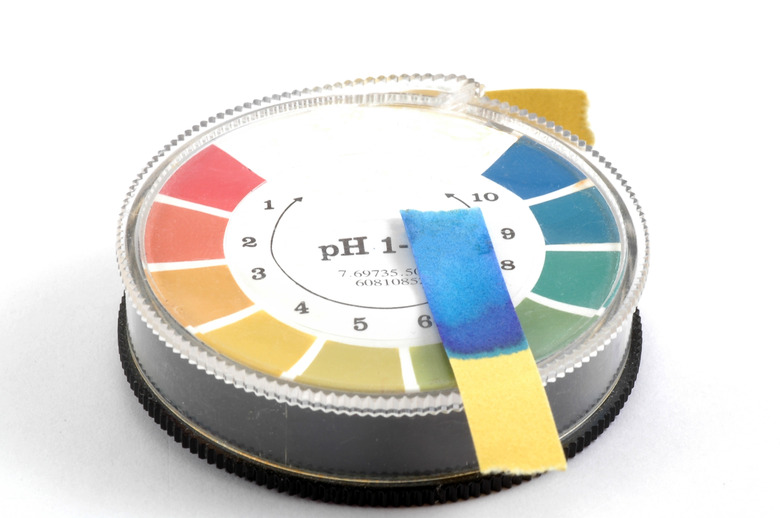What Products Does One Get When Mixing An Acid & With A Base?
A chemical reaction by definition forms new chemicals (called the products) from the initial chemicals (called the reactants). It should make sense that the identity of the products formed depends on what reactants we start with. Adding an acid to a base is an example of a chemical reaction, so we should expect to see new products. Although there is a pattern to this type of reaction, ultimately the products formed depend on what acid and what base are used.
Not an Easy Answer
Not an Easy Answer
At first glance, this question has a simple answer. Most introductory chemistry books will teach that the reaction between an acid and a base is called neutralization, and the products formed are water and a salt. For example, if you mix hydrochloric acid (HCl) with sodium hydroxide (NaOH), the products formed are water (H20) and sodium chloride(NaCl), which is well-known as table salt.
HCl + NaOH –> H2O + NaCl
The problem is that it isn't really that simple. To completely answer this question, we will have to be a lot more specific.
A Starting Point
A Starting Point
Let's start by mixing a strong acid with a strong base. Adding the word "strong" means that these acids and bases completely dissociate (or break apart) when put into water. Using a strong acid in an experiment means the acid is already dissolved in water (and this is most likely true for the base, too). If you then add the acid to the base, the products will be water (in addition to the water already there) and a salt (which is not necessarily "table salt").
For example, mix the strong acid HNO3 (nitric acid) with the strong base KOH (potassium hydroxide).
HNO3 + KOH –> H2O + KNO3
In this example, KNO3 is the salt, so water and a salt are formed as expected. This reaction takes place in water, so most likely the salt is not bonded together, but instead is separated as ions in the water.
The Complete Ionic Equation
The Complete Ionic Equation
Actually, chemists write what is called a complete ionic equation to show which chemicals are dissociated:
H+ (aq) + NO3- (aq) + K+ (aq) + OH- (aq) –> H2O (l) + K+ (aq) + NO3- (aq)
This long equation shows that the strong acid and strong base are dissociated in the water ("aq" stands for aqueous), and water is formed, leaving potassium (K+) and nitrate (NO3-) ions still in the water.
The Net Ionic Equation
The Net Ionic Equation
This leads to another interesting question: How is a salt formed? In this case, it isn't. The ions that would form the salt are there, but in the present form they haven't formed the salt. So, chemists write what is called the net ionic equation to show what really happened:
H+ (aq) + OH- (aq) –> H2O (l)
This tells us that the only true reaction is this example is the formation of water. The ions K+ and NO3- haven't done anything, so they are left out of the net ionic equation.
Complicating Neutralization with Stoichiometry
Complicating Neutralization with Stoichiometry
What if you wanted to end up with the products only–salt and water–and wanted to be sure that all of the acid and base were gone? This becomes a stoichiometric problem. Without adding enough base, there will be acid left over from the reaction. The acid is not a product, but it is mixed in with the products. Likewise, adding too little acid, would result in a left over amount of base, which again would be mixed with the products. Mathematically, you can calculate just how much acid you should mix with a certain amount of base to achieve complete neutralization.
Weak Acids, Weak Bases and Gas Formation
Weak Acids, Weak Bases and Gas Formation
What if the acid or base (or both) isn't "strong"? There are many weak acids and bases, which means that they dissociate very little when mixed in water. Simply stated, neutralization still takes place (forming water and a salt), but if we go beyond that simple statement, we find that the complete ionic and net ionic equations are very different from a strong acid/strong base reaction.
There's one more complication: What if an acid is mixed with something like NaHCO3? Consider the well-known reaction that takes place when you mix baking soda (NaHCO3) with acidic vinegar. A gas is formed. Neutralization takes place, but the products are no longer only water and a salt.
Look at hydrochloric acid and baking soda, for example:
HCl + NaHCO3 –> NaCl + H2O + CO2
The products are not only a salt (NaCl) and water (H2O), but also a gas (CO2).
Conclusion
Conclusion
There is no simple solution to the problem of what products one gets when mixing an acid with a base. The end result of mixing and acid with a base depends on which acid and base are used and on how much acid and base you use. The strength or weakness of the acid and base also impacts the products of the reaction. In general, these reactions lead to the formation of a salt plus water and sometimes a gas.
Cite This Article
MLA
Hoff, Amanda. "What Products Does One Get When Mixing An Acid & With A Base?" sciencing.com, https://www.sciencing.com/products-one-mixing-acid-base-2450/. 22 May 2018.
APA
Hoff, Amanda. (2018, May 22). What Products Does One Get When Mixing An Acid & With A Base?. sciencing.com. Retrieved from https://www.sciencing.com/products-one-mixing-acid-base-2450/
Chicago
Hoff, Amanda. What Products Does One Get When Mixing An Acid & With A Base? last modified August 30, 2022. https://www.sciencing.com/products-one-mixing-acid-base-2450/
